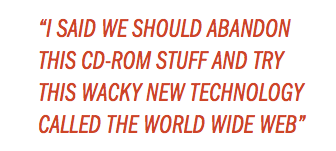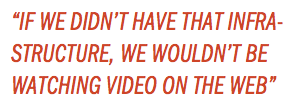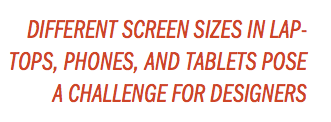From dial-up to broadband to the now, not only has the way the Internet comes down the tubes changed, the way it looks has too.
In October 1994, Columbia Journalism School was in the process of finalizing its curriculum for the spring semester. The plan was to focus its one multimedia course on CD-ROMs, which were heralded for being able to store and play high-quality audio and video on computers. Andrew Lih, then in his first year teaching at the Ivy League school, proposed a different idea. “I said we should abandon this CD-ROM stuff and try this wacky new technology called the World Wide Web and we should use a browser called Mosaic,” he recalls. “They kind of looked at me and said, ‘Are you sure? We’ve never heard anyone talk about this stuff before’. And I said, ‘Trust me, we gotta do this.’
Despite their impressive capabilities, Lih saw one big drawback to CD-ROMs: They aren’t networked. While the Web was still in its primitive stages, it had one major appeal: that a user could connect to anyone, anywhere. Combine that with the recent invention of the Mosaic browser, which allowed images to be placed in line with text on the same page, and tech geeks were, well, geeked at the possibilities for the future.
Columbia followed Lih’s advice, and in January 1995 it became one of the first journalism schools to offer a class on authoring for the Web. What followed has been an age of design development in which Web pages have rapidly evolved to what we recognize today—and presents possibilities in the near-future that’ll boggle your mind.
The dial-up ages
Before Mosaic and the World Wide Web, there was one application that was hugely influential for Internet designers: Apple’s HyperCard, which came out in 1987. Experienced programmers to novices were able to create pages of content out of virtual stacks using the Mac’s user-friendly drag-and-drop function. “HyperCard was the gold standard that all of the early Web technologists looked to in terms of what can we do with layout and design,” says Kevin Hughes, a design pioneer who was one of six people named to the World Wide Hall of Fame in 1994. “What are the possibilities when it comes to combining links and text and rich text and images? It was really HyperCard that sparked a lot of imaginations.”
HyperCard fizzled in popularity after Tim Berners-Lee published the first Web site in late 1990 and when CERN declared the Web to be public domain in 1993. It was at that time that the Mosaic browser pushed the Web out of its Neolithic era of one-column all-text pages. “We saw that and said, ‘This is going to change everything,’” says Lih, now a professor at USC Annenberg.
Mosaic (and shortly after, Netscape) gave programmers the breakthrough they were looking for in their goal of one day bringing the best qualities of CD-ROMs to the Internet. “Certainly the people who were doing the Web were foreseeing multimedia images and movies from the beginning,” says Marc Weber, the founding curator of the Internet History Program at the Computer History Museum, in Mountain View, California. “It was text-only [at first] because it was the easiest thing to do.”
The next significant design advancement in the mid ‘90s was a subtle one: advanced tables functions made it possible to organize content into multiple columns. This design protocol has carried through into the modern era of website production. “You don’t notice, but a lot of things on the Web are [still] in some kind of table,” says Weber.
Around this time, the development of Java and Flash helped to replicate even more of the CD-ROM’s multimedia qualities online. However, slow dial-up connections continued to hamper the user experience, which meant heavy content like a TV episode would have taken an eternity to download.
The broadband era
The advent of broadband was the next major milestone in Web design. The late ‘90s saw the beginnings of high-speed Internet on college campuses. “I remember getting my first cable modem and what a big deal that was for what I was able to download,” says Anthony Casalena, the 31-year-old Founder and CEO of Squarespace. “If we didn’t have that infrastructure, we wouldn’t be watching video on the Web.”
Still, in the early 2000s much of the non-academic world was stuck with slow dial-up connections. “You started to see all these young kids who went to college and were so spoiled by fast connections on campus,” says Lih. “The moment they turned 22 and stepped off campus they were thrown into this primitive environment of much slower connections. That spurred the development of broadband because people were willing to pay $30 to $40 a month for it.”
The increase in bandwidth for the masses was a game-changer for website designers. Instead of images trickling in as progressive JPGs and videos taking hours to download, they could be viewed almost instantly with the faster connections. Yet, while the multimedia experience greatly improved, Web pages were often cluttered and ugly. “There was this ‘everything on the page’ mentality,” says Casalena. “I remember very few people with a simple, to-the-point uncluttered Web page.”
The rebirth of simplicity
By the mid 2000s, Cascading Style Sheets (CSS)–the presentation language–had become more sophisticated and browsers such as Chrome and Firefox were paving the way for sleeker-looking sites. Instead of cramming content on a page, there was a movement toward interactivity. This was in conjunction with the rise of Ajax, a suite of technologies that allowed sites to load content in the background without a user having to refresh the page. “We laughed at the idea of Web 2.0 at the time, but Ajax changed our notion of the Web from just pages and documents, and this marked the dawn of the Web as an application platform,” says Stephanie Troeth, a user experience strategist and featured presenter at London’s Future of Web Design conference.
Since 2007, the trend in Web design has focused on presenting information clearly and simply. “People are becoming more comfortable with the medium and looking to differentiate themselves,” says Casalena. “We’ve gotten to the point where some of the graphic design elements and rules from traditional design and illustration are making their way to the Web.”
The other reason for simplicity: the increase of mediums in which the Web is viewed. In 2007, the first iPhone came out, and its Safari browser was the most sophisticated to date on a mobile device. “It really opened a lot of peoples’ eyes as to how we need to deal with different resolutions, touch elements, and different modes and ways of interacting with content,” says Hughes. “Now we needed design tools that allowed people to build user interfaces that could work optimally in all of these environments and situations.”
The result has been Responsive Design—uniform layouts that can adapt to and look the same on any size of screen from laptop to smartphone to tablet. “As smartphones get more common, you’re going to get billions of people who have never experienced the Web with a computer, only with a mobile device,” says Weber. “Clearly that’s going to affect the way people design websites.”
The rise of different screen sizes in laptops, phones, and tablets poses a challenge for designers. But in just a few years, we may not be viewing content on screens much at all, says David Carroll, the Director of the MFA Design & Technology program at Parsons School for Design in New York City. “The role of the screen will radically change in the coming five to 10 years where it will become more ubiquitous and less central in our lives,” says Carroll. “We won’t spend so much of the day just staring at the screen in front of us. That the screen will be embedded more into our environments.”
Computers and microcontrollers are becoming smaller and cheaper and with the advent of technology like digital fabrication, 3D printing, and laser cutting, we are already seeing many developments in physical objects that are connected to the Internet. “Today, our touchscreens are the size of tablets and phones. Tomorrow they could be the size of a wall, the size of a traditional newspaper, the size of a pay phone,” says Hughes. “How do you deal with such varying resolution requirements? It’s going to a very challenging design environment coming up.”
Even with the big advances in multimedia capability over the years, Web pages have come full circle in some ways, embracing the simple look and interactive nature that its pioneers envisioned more than 20 years ago. As the Web expands beyond screens and into objects of varying shapes and sizes, the pressure is on designers to adapt and move their craft forward. “The nature of design and innovation is that we get better over time,” says Troeth. “Overall, where we can go from here is to pay closer attention to designing better and complete user experiences—beyond the screen, device, or app. We need to do what is necessary to ensure that users get the best end-to-end experience possible.”







